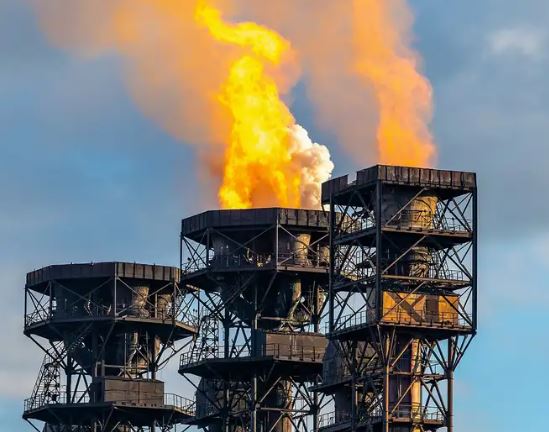While carbon dioxide (CO2) accounts for the largest share of human-caused global greenhouse gas emissions, other heat-trapping gases also significantly contribute to climate change. Key among these is methane, an extremely potent albeit shorter-lived greenhouse gas. Experts warn methane concentrations now pose major risks for dangerous climate tipping points. But opportunities exist to cheaply reduce methane and other non-CO2 emissions to quickly slow warming rates in the critical near-term even as CO2 cuts ramp up.
The role of methane and non-CO2 gases in driving climate change
According to the Environmental Protection Agency (EPA), the main greenhouse gases contributing to climate change include:
- Carbon dioxide (CO2)
- Methane (CH4)
- Nitrous oxide (N2O)
- Fluorinated gases (hydrofluorocarbons, perfluorocarbons, sulfur hexafluoride, nitrogen trifluoride)
While CO2 accounts for roughly 80 percent of all U.S. greenhouse gas emissions as of 2022, the much smaller volumes of non-CO2 pollutants play an outsized role due to their higher heat-trapping potential.
This disproportionate impact makes sense when comparing the global warming potentials (GWP) of different greenhouse gases. GWP measures how much a gas warms the atmosphere over a 100-year timeframe relative to an equal mass of CO2. The higher the GWP, the more a gas warms the planet.
According to the IPCC Sixth Assessment Report, methane has a GWP of 85 over a 20-year period and 30 over 100 years. This means a single ton of methane emits 85 and 30 times more warming respectively over these periods than a ton of CO2. Nitrous oxide has a GWP of 273 over 100 years while sulfur hexafluoride sits extremely high at 22,800.
Due to their sheer volume, CO2 emissions still drive roughly 75 percent of human warming effects since the pre-industrial era. However, methane now contributes 17 percent according to the Global Carbon Project, with other non-CO2 gases responsible for the remaining 8 percent. While this non-CO2 share may seem small, reducing these emissions can significantly impact short-term warming rates while economy-wide CO2 reductions scale up.
Methane concentrations rising faster
Methane deserves particular focus as concentrations have risen over 160 percent above pre-industrial levels compared to 50 percent for CO2 as of 2022. And after stalling in the early 2000s, methane began rapidly rising again around 2007.
Scientists still debate complex reasons for renewed methane growth, with possible culprits including expansion of tropical wetlands, fossil fuel production, biomass burning, and livestock farming among others. However regardless of exact origin models show current trends may significantly increase risks of extreme warming and feedback effects. This highlights the importance of urgently targeting methane given its outsized near-term impacts.
Large mitigation potential from methane and non-CO2 emissions
The good news is reducing non-CO2 emissions can rapidly decrease warming trajectory in the critical next decade as the world simultaneously works to decarbonize energy and transport. Unlike CO2 which accumulates for centuries, methane degrades relatively quicker over approximately 12 years. Other pollutants like nitrous oxide or refrigerants feature shorter but still meaningful atmospheric lifespans.
This means cutting methane and non-CO2 emissions can substantially slow short-term temperature rise even before economy-wide CO2 reductions fully kick in. One recent study in Science found just reducing methane leaks, venting, and flaring to virtually zero could decrease projected warming almost 1°F by 2050. At the same time more gradual CO2 cuts exert a bigger impact by 2100. Still targeting faster-acting pollutants buys vital time needed for transforming the much larger global energy system.
Studies consistently show existing technologies can cut methane emissions from oil and gas over 75 percent at very low costs using improved infrastructure, leak detection, and capture systems. Further reductions are feasible across agriculture, landfills, and other methane sources like biomass burning. Switching refrigerants and other industrial chemicals in line with the Kigali Amendment to the Montreal Protocol also promises major quick mitigation wins.
While eventually eliminating most non-CO2 emissions, experts argue targeting these 50 percent cuts possible by 2030 could steer 0.3°C away from dangerous climate thresholds. And for maximum risk reduction, some propose even larger cuts of 75 percent combined with aggressive CO2 mitigation.
Policies strengthening but more non-CO2 focus essential
In a promising signal, recent policy momentum shows growing recognition of fast-acting pollutants’ importance for climate goals. Domestic measures like the newly enacted Inflation Reduction Act will help mitigate methane through fees, pipeline upgrades, and environmental justice. On the world stage, over 120 countries recently joined the Global Methane Pledge to cut emissions 30 percent by 2030, although mechanisms for sufficient accountability and support remain debated.
However current policies still fall short of emission reductions needed this decade across all greenhouse gases. The world requires an all-in effort on both CO2 and non-CO2 mitigation for any hopes of stable climates. While long-term CO2 cuts do the heavy lifting, targeted methane and refrigerant measures maximize warming reductions in the near-term critical window as transformations scale up. Climate models clearly show addressing CO2 alone cannot achieve Paris Agreement targets without also managing often overlooked fast-acting pollutants.
Through urgent economy-wide decarbonization combined with methane, refrigerant and nitrous oxide mitigation, experts state the world can still restrict warming to 1.5-2°C. Yet time is running short for serious climate action on all fronts. The small silver lining is unlike entrenched CO2 infrastructure, targeted non-CO2 policies can more swiftly benefit climate in coming years if enacted now. But delayed policies risk yet higher concentrations and feedback effects. Hopefully recent promising steps translate into greater climate policy focus on neglected methane and fellow heat-trapping emissions alongside the long slog of energy transition.
